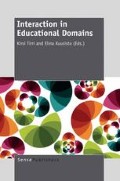Abstract
The purpose of this chapter is to examine how multicultural students interpret classical Finnish paintings of Finland’s golden age. The chapter focuses on classroom interaction in the visual arts. Visual culture seems to be taking an increasingly large role in every pupil’s life. Even in early childhood, pupils are surrounded by masses of different images and visual types of communication.
Access this chapter
Tax calculation will be finalised at checkout
Purchases are for personal use only
Preview
Unable to display preview. Download preview PDF.
References
Alasuutari, P. (1993). Laadullinen tutkimus [Qualitative inquiry]. Tampere: Vastapaino.
Begnaud, A. D. (2004). Enhancing visual literacy and communication skills of fifth graders through the use of student-selected artworks. Valdosta State University.
Branton, B. (1999). Visual literacy, literature review. Retrieved December 26, 2001, from http://vicu.utoronto.ca/staff/branton/litreview.html
Chanlin, L. (1999). Gender differences and the need for visual control. International Journal of Instructional Media, 26(3), 329–335.
City of Helsinki Urban facts. (2013). Retrieved February 15, 2013, from http://www.hel.fi/hki/Tieke/fi/Etusivu.
Efland, A., Freedman, K., & Stuhr, P. (1996). Postmodern art education: An approach to curriculum. Reston, VA: The National Art Education Association.
Eisner, E. (2002). The arts and the creation of mind. New Haven & London: Yale University Press.
Emery, L., & Flood, A. (1998). Visual literacy. University of Canberra, Australian Centre for Arts Education. Retrieved December 18, 2012, from http://education.canberra.edu.au/centres/acae/literacy/litpapers/vislit.htm
Eskola, J., & Suoranta, J. (2001). Johdatus laadulliseen tutkimukseen. [An introduction to qualitative inquiry]. Tampere: Vastapaino.
Flattley, R. (1998). Visual literacy. Pima Community College, Downtown Campus Psychology Department. Retrieved January 3, 2013, from http://dtc.pima.edu/psychology/Visual_Literacy.html
Freedman, K. (2003). Teaching visual culture: Curriculum, aesthetics, and the social life of art. New York, NY & Reston, VA: Teachers College Press and the National Art Education Association.
Giorgis, C., Johnson, N. J., Bonomo, A., Colbert, C., Conner, A., Kauffman, G., & Kulesza, D. (1999). Children’s Books: Visual Literacy. The Reading Teacher, 53(2), 146–153.
Hall, S. (1999/2002). Identiteetti (M. Lehtonen & J. Herkman, Trans.) [Identity]. Tampere: Vastapaino.
Hall, S. (Ed.). (1997). Representation. Cultural representations and signifying practices. London, UK: Sage.
Heinich, R., Molenda, M., Russell, J. D., & Smaldino, S. E. (1999). Instructional media and technologies for learning (6th ed.). Upper Saddle River, NJ: Prentice-Hall.
Kairavuori, S. (2012). Kumouksellinen strippi – Sarjakuva toisin ajattelemisen taitona [Comics in terms of critical thinking skills]. The Finnish Journal of Education, 43(2), 135–145.
Karjalainen, T. (2009). Kantakuvat. Yhteinen muistimme [Stem images. Our shared memory]. Helsinki: Maahenki Oy.
Kellner, D. (1998). Multiple literacies and critical pedagogy in a multicultural society. Educational Theory, 48(1), 103–122.
Kolb, D. A. (1984). Experiential learning: Experience as the source of learning and development. Englewood Cliffs, NJ: Prentice Hall.
Laaksola, H. (2011, February 25) Maahanmuuttajat ovat kouluille rikkaus ja rasite [Immigrants are both wealth and a burden for schools]. Opettaja, 8–9, pp. 16–19.
Lehtonen, M. (2009). Linquistic nations – auditive and visual world. In H. Ruismäki, & I. Ruokonen (Eds.), Arts contact points between cultures (pp. 111–116). University of Helsinki: Department of Applied Sciences of Education.
Mikkola, P. (2001). Kahden kulttuurin taitajiksi. Maahanmuuttajaoppilaan monikulttuurinen identiteetti, tavoitteet ja toiminta [Acquiring bicultural competency: The immigrant pupil´s multicultural identity, goals, and actions]. (Doctoral dissertation). The University of Turku. Turku: Painosalama Oy.
Mäkiranta, M. (2010). Kuvien lukeminen [Reading images]. In J. Hurtig, M. Laitinen, & K. Uljas-Rautio (Eds.), Ajattele itse! Tutkimuksellisen lukutaidon perusteet [Think for yourself! Principles of research literacy]. Jyväskylä: PS-kustannus.
Nieto, S. (1999). The light in their eyes. Creating multicultural learning communities. Teachers multicultural identity, goals and actions. New York: Teachers College Press.
Paavola, H. (2007). Monikulttuurisuuskasvatus päiväkodin monikulttuurisessa esiopetusryhmässä [Multicultural education in a multicultural kindergarten pre-school group]. (Doctoral dissertation). University of Helsinki. Retrieved from http://urn.fi/URN:ISBN:978–952-10–3850-1
Parsons, M. J. (1987). How we understand art: A cognitive developmental account of aesthetic experience. Cambridge University Press.
Pääjoki, T. (2004). Taide kulttuurisena kohtaamispaikkana taidekasvatuksessa [The arts as a place of cultural encounters in arts education]. (Doctoral dissertation). Jyväskylä: University of Jyväskylä. Retrieved from https://jyx.jyu.fi/dspace/bitstream/handle/123456789/13418/9513919978.pdf?sequence=1
Räsänen, M. (2008). Kuvakulttuurit ja integroiva taideopetus. [Visual cultures and integrative art teaching]. Helsinki: University of Art and Design.
Räsänen, M. (2012). Cultural identity and visual multiliteracy. Full paper presented at the InSEA European conference, Limassol, Cyprus.
Seppänen, J. (2001). Katseen voima. [The power of the gaze]. Vastapaino. Tampere.
Sinatra, R. (1986). Visual literacy connections to thinking, reading and writing. Springfield, IL: Charles C. Thomas.
Stokes. S. (2002). Visual literacy in teaching and learning. A literature perspective. Electronic Journal for the Integration of Technology in Education, 1(1). Retrieved from http://ejite.isu.edu/Volume1No1/stokes.html
Strauss, A., & Corbin, J. (1994). Grounded theory methodology. An overview. In N. K. Denzin & Y. S. Lincoln (Eds.), Handbook of qualitative research (pp. 273–285). California: Sage Publications.
Talib, M-T. (2001). Monikulttuurisuudesta matka minuuteen [The Journey from multiculturalism to the self]. In I. Sava (Ed.), Taikomo projektin päättyessä. Helsinki: Helsingin kaupungin opetusvirasto.
Valkonen, M. (2004). Kultakausi. [The Golden Age ]. Helsinki: WSOY.
Williams, T. L. (2007). Reading the painting. Exploring visual literacy in the primary grades. Reading Teacher, 60(7), 636–642.
Author information
Authors and Affiliations
Editor information
Editors and Affiliations
Rights and permissions
Copyright information
© 2013 Sense Publishers
About this chapter
Cite this chapter
Knif, L., Kairavuori, S. (2013). Cultural Aspects in Understanding the Visual Arts. In: Tirri, K., Kuusisto, E. (eds) Interaction in Educational Domains. SensePublishers, Rotterdam. https://doi.org/10.1007/978-94-6209-395-9_10
Download citation
DOI: https://doi.org/10.1007/978-94-6209-395-9_10
Publisher Name: SensePublishers, Rotterdam
Online ISBN: 978-94-6209-395-9
eBook Packages: Humanities, Social Sciences and LawEducation (R0)


